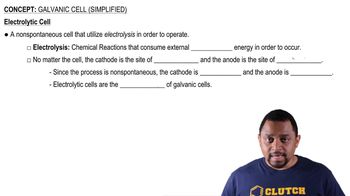Here are the essential concepts you must grasp in order to answer the question correctly.
Elements, Compounds, and Mixtures
Elements are pure substances that cannot be broken down into simpler substances by chemical means. Compounds are substances formed when two or more elements chemically bond together in fixed proportions, and they can be broken down into their constituent elements. Mixtures consist of two or more substances that are physically combined and can be separated by physical means. Understanding these definitions is crucial for classifying the substances in the question.
Recommended video:
Electrolysis
Electrolysis is a chemical process that uses electricity to drive a non-spontaneous reaction, often used to decompose compounds into their elements. In the context of the question, passing electricity through the molten solid indicates that it is likely a compound, as it produces a molten metal and a gas, suggesting a breakdown into simpler substances. This process helps in identifying the nature of the original white solid.
Recommended video:
Galvanic Cell (Simplified) Concept 2
Physical and Chemical Properties
Physical properties can be observed without changing the substance's identity, while chemical properties describe how a substance interacts with other substances. The melting point of the white solid and the production of a gas and metal upon electrolysis are key indicators of its chemical nature. Recognizing these properties aids in determining whether the substances are elements, compounds, or mixtures.
Recommended video:
Physical Properties Example
 Verified step by step guidance
Verified step by step guidance


